Thank you to the Whyte Museum of the Canadian Rockies for granting permission to the Park Warden Service Alumni to post this interview on our website.
This Oral History interview was funded in part by a research grant received in 2019 from the Government of Alberta through the Alberta Historical Resources Foundation.
Park Warden Alumni Society of Alberta
Oral History Phase 9, 2019
Phone Interview with Jim Purdy
Date/time: July 19th, 2019, 2000
Interviewed on the phone by Monique Hunkeler
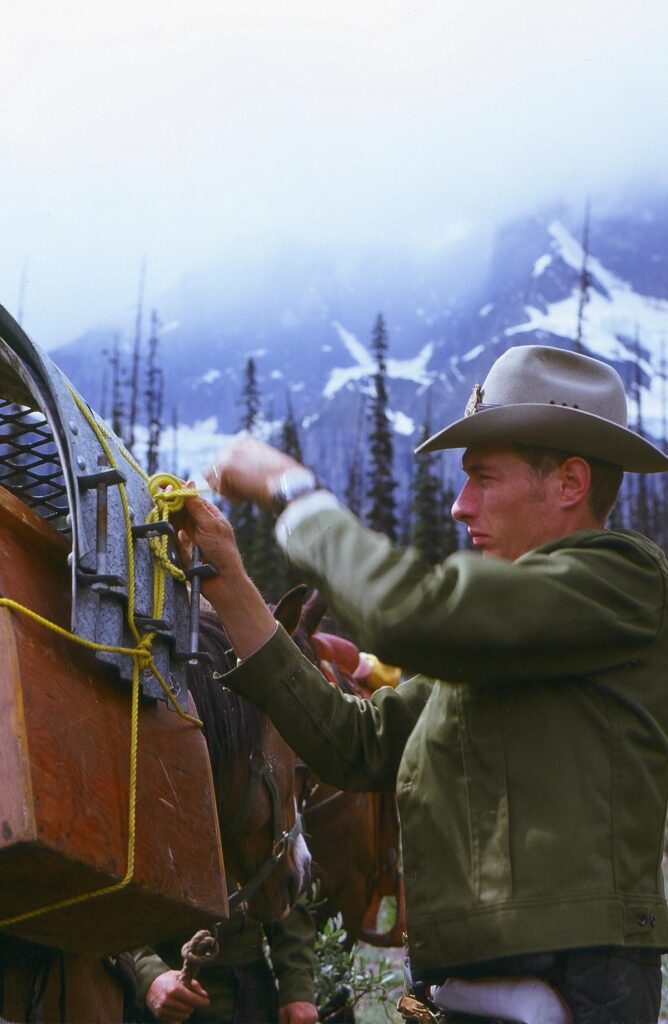
Place and date of birth? JP: Born Nanaimo, BC in 1950
MH: Where did you grow up?
JP: I was born in Nanaimo, BC where I lived for 12 years, before moving south to Chemainus. In 1964 my parents and I moved to Wabasca, Alberta where I stayed for one year. I took Grade 10 in Athabasca and Grades 11 and 12 in Peace River. After I graduated from High School I attended the University of Alberta.
MH: How did you become involved in the Warden Service? Which national park did you start working in?
JP: I was looking for a job in my final year at University where I was doing a Bachelor of Science. I came across an ad for Park Naturalists and applied and was accepted in Yoho National Park. Before I arrived at Yoho, I saw an ad in the Edmonton Journal for the Warden Service. and I thought, “Wow now that sounds like an interesting job.” I had never heard of the wardens before that.I talked it over with my father and he said, “Well you’re in the parks now, so why don’t you wait and see what it’s like and move from there”. I was a naturalist for a year and then got hired on as a seasonal Park Warden in May 1973 at Yoho.
MH: What made you want to join the Warden Service?
JP: While I was a naturalist I learned about the Park and how the Wardens functioned. There were still people in the districts and the whole thing just seemed where I needed to be.
MH: What different parks did you work in? How did they compare? Do you have a favourite? 0257:
JP: I was in Yoho from May 1972 until December 1973. I was transferred to Wood Buffalo National Park in a permanent position. I was there until April 1975 when I returned to Yoho. My career ended in June 1977 when I resigned. The two parks were vastly different. Yoho was a small park, all the wardens lived in the park and we were sort of working all day every day, always on duty type of thing. Wood Buffalo is huge with no park personnel living in the park. I was based in Fort Smith which was 20-25 miles from the park. We would drive along the highway towards Hay River or around the loop road by Peace Point and Hay Camp but if we were actually going to go out into the park it was a major undertaking as we would likely be gone for a week or more. Everyone in town knew you were going before you were gone. It was very different. Yoho was my favourite of the two parks. I only worked a total of five years in the parks and then got into ranching in Manitoba and later became a teacher.
MH: What were some of your main responsibilities over the years? 0520:
JP: I was primarily involved with Resource Conservation. When I was in Yoho, I wrote the initial Resource Conservation Plan and was very involved in the natural resource inventory that was taking place throughout the mountain parks. I was also involved in the backountry and Law Enforcement.
MH: What did you like / Dislike about being a warden? 0540:
JP: I joined during the move towards centralization. Yoho is a small park and training was intense and over a very broad spectrum. It seemed that everybody was trained in everything. In larger parks a warden was usually selected for specific schools and training was more specialized. In Yoho we did them all: skiing, climbing, rescue, firefighting, law enforcement, and conservation. It was very exciting to have the opportunity to get into all of those fields. When I’d go into the backcountry I’d often say, “Am I getting paid for this?” The warden service was a very elite organization; highly trained and highly respected. I did find the bureaucratic red tape very frustrating and I think that was a major reason why I didn’t stay.
MH: What were some of your more memorable events as a Warden? 0700:
JP: Probably my most memorable event occurred in 1974 when Ruth and I were married in Field and I wore my Warden uniform. In 1976 I was Parks Canada representative for the US Bicentennial at the Calgary Stampede at a joint exhibit on the Gold Rush and the trails into the Klondike. I was also involved in a Bison slaughter while at Wood Buffalo which was rather unique, at least during my time.
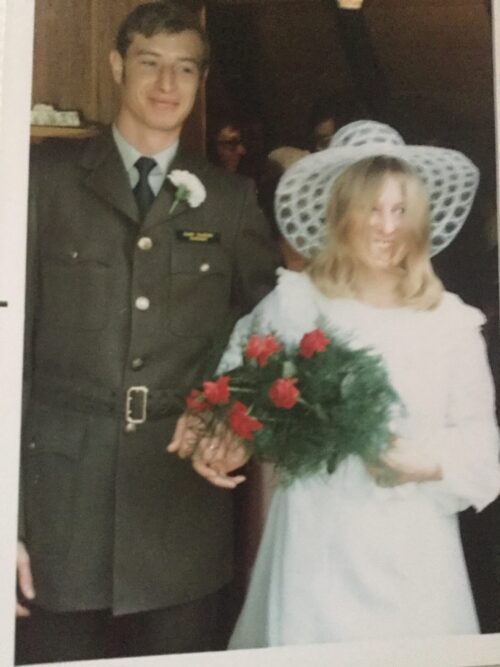
MH: Can you tell me about any rescue/wildlife stories that stick out in your memory? 1920:
JP: There are two rescues that have really stuck in my mind. One was probably the first time I worked with Tim Auger. He was at Lake O’Hara and we had an overdue party coming into the park over Opabin Pass. Tim and I hiked up to the pass and spotted the father and son coming up the other side. It was cold and the wind was blowing so we went back over the pass, down out of the wind. Tim used his camp stove and brewed up some soup and soon the father and son showed up. The boy was about 10 and his feet were soaked and his lower pants were wet and he was cold and shivering. Tim gave him soup, changed his socks and began telling stories. Before you knew it, the boy was laughing and when we went down off the pass, he was sliding down the snow and having a heck of a time. I was impressed. To me, that was Tim.
0941: Another rescue/retrieval was on Chancellor Peak. There was a reported overdue climbing party. I had checked the registrations at the West Gate in the morning as I usually did and was on my way into the Operations Centre when I received a call from Gordon Rutherford asking if I had checked the West Gate registrations. I told him there were no climbs registered out. He suggested I check again as he had somebody on the phone saying a party had signed out and now were overdue. I rechecked and found the registration buried deep down in the book but it was another 1-2 days before they were due out. The party was very concerned so a chopper was brought in and Gordon and Dale Portman flew the route. They observed where a slide wiped out the trail and followed the slide path down and found gear on the show. I was lifted in and helped dig out the three climbers.
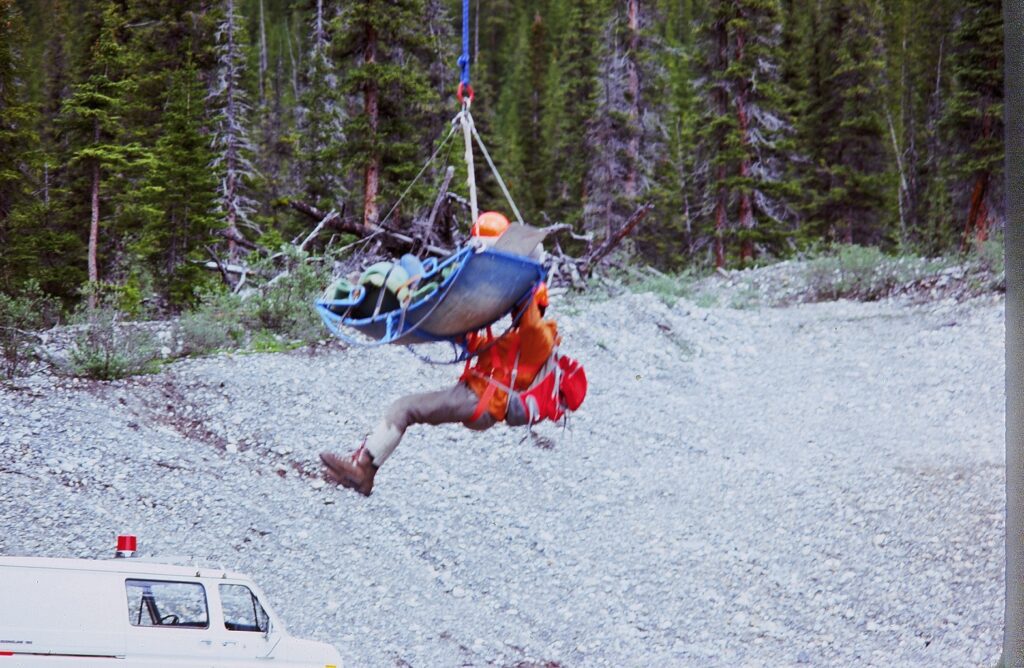
Helicopter rescue training. YNP. 1974
1126: There were some wildlife incidents that always stuck with me. One was when I was in Wood Buffalo. The Girl Guides had a group camp at Pine Lake and there was a young sow with three cubs there that was beginning to be a real nuisance. I set up the bear trap and we caught the mother very quickly but the three cubs were all up in the tree. We had quite a time getting those cubs. I thought, I was a bit of a cowboy so I to took my rope up tree and to catch a cub. When I got close to the cubs, the lowest one decided he was going to come down and meet me and I thought, “This is not a good idea!” We ended up cutting down the tree and caught one cub when it fell. That night I relocated the sow and one cub and came back the next morning and managed to get the two other cubs. These were released in the same area and we just hoped they’d reconnect with the sow. Following this incident Wood Buffalo National Park did get tranquilizing equipment.
As I mentioned earlier, I was involved in a Bison slaughter. There hadn’t been one for a number of years and I don’t think there was another one for a long time. The Park was instructed to conduct the slaughter in January and it was cold. The thermometer registered -560F. The propane bottles were brought into the cook shack to get warmed by the wood stove so that the propane would flow. The helicopters that were being used to herd the animals into the corrals had little luck moving any Bison and consequently there were only around 50 animals available for slaughter. This wasn’t the most inspiring event I ever participated in but due to its uniqueness, I was glad I had the opportunity to participate.
1312: Another story in Wood Buffalo was a poached Bison. It was shot but left lying on the side of the road to Hay River. Two of us went out and found the carcass and tracks. We found tracks with identifiable footprints and on the way back to town we saw where a vehicle had pulled over in the snow and found similar same tracks, shell casings from a 9mm handgun, and impressions where a couple of 5-gallon pails had been stuck in the snow. The picture we put together was a van, somebody with a handgun and these pails. So we got back to Fort Smith and I went and talked to one of the members at the detachment whom we often worked with and he went through their files until came across an individual in town that seemed to fit the evjidence we had. I thought this is our guy: all we needed was a search warrant, but the member said, “No, we don’t have enough”. I was determined that this was our culprit but was informed that, “If it’s him we’ll get him but we can’t just run in there with what we have.” I went home but I was convinced that this was our poacher. The RCMP officer spoke with other members and one of them said, “Oh by the way, so and so was here from Yellowknife detachment and he was hunting this weekend”. A phone call was made to Yellowknife and the Staff Sergeant met the member in question when he came into work on the nightshift. The Staff Sergeant asked how the hunting trip went and the constable looked at the Staff Sergeant and said, “It wasn’t very good, we shot a buffalo.” His story was he was asleep and was woken up by the shots and thought, “What are we going to do?” and they left carcass and ran. We got convictions and the constable was transferred to the east coast.
1655: I had another poaching incident in Yoho National Park. This one didn’t turn out so well. It was during hunting season and I left before dawn to look for any activity along the Beaverfoot River on the west boundary. I wasn’t in uniform and I was just going to go out and wander in the area. On the road about 4-5 miles from town I passed a pickup parked on the north side of the road. I slowed down and checked the vehicle but I was running behind my schedule and kept on going. As I returned later in the morning I heard chatter on the radio about a dead elk that had been found on the south side of the road where I had spotted the pickup. The hunters were likely dressing out the elk as I went by. I didn’t get the license number or anything. We never did get that party.
1836: There were a lot of stories that stand out in my memories. One is about Jim Davies, our helicopter rescue pilot from Banff. Jim was the first pilot in Canada licensed to fly rescues with personnel hanging below the chopper. He was absolutely incredible and we trusted him completely. I mentioned that I joined when there was a surge of training going on. I didn’t realize this was anything out of the ordinary. To me this was the norm and in hindsight it was a very special time because of this training. A lot of the things we did in mountain rescue were on the cutting edge but I didn’t realize it at the time. I thought this was just what mountaineers did, hanging under the helicopters etc. But we trusted Jim and he was absolutely incredible. This particular day, four of us were putting a radio repeater up on Mt. Stephen. It took most of the morning for Jim to ferry us, the structure, and our gear to the summit. We took our packs in case we had to bivouac or hike out. We worked all day up there and at about 4:00 Jim said, “There is a storm coming in so you guys have to either come now or you’re here for the night”. We decided to go down and we all piled in with our packs on our knees and he said, “You know, we are pretty high and the air is thin so I don’t know if we can get off of here or not with this load.” He bounced the helicopter a few times and thought it was safe so he picked it up and just dropped it over the edge. There was just a straight cliff all the way down and it was flying by us. I asked, “Hey Jim, how fast do you think we are going?” and he nonchalantly replied, “Well if I shut the rotor off, I don’t think we would go any faster – but don’t worry when the air gets thicker lower down below the rotor will grab.” That was Jim’s sense of humor.
MH: How did the Warden Service change over the years? 2200:
JP: The Warden Service and Parks Canada in general were in the midst of change when I hired on. Centralization was in full swing and the districts were closing down. Yoho is a small park and all the wardens were exposed to a wide spectrum of training opportunities in a number of areas making us generalists. It was really an exciting time. I left the Warden Service after a short time but I’ve kept in touch with many of the Wardens that I had worked with Many times I’ve looked back and thought how I miss that life and wish I was still there but when I talked to those that stayed in, I think I was so lucky I got out when I did. I left with good memories and not the bitterness I have seen others exhibit. I wasn’t a warden that long but it made an absolute incredible impression on my life. It’s hard to picture that such a short period made such a big impact. The Warden Service was like a big family. When I was in Wood Buffalo, Sandy Maclean came out from the Maritimes to be an area manager. He was a fantastic guy and I enjoyed working with him. After I left the service I lost contact with Sandy but years later my wife and I went to Newfoundland and I was in talking to one of the Wardens in the park office and happened to mention Sandy’s name. He knew Sandy. It was so neat, all the way across the country and the first warden I ran into, we had a mutual friend. A lot of the experiences I had in the park came with shared dangers, shared excitement, or the rough life in the backcountry.
MH: What about the Warden Service was important to you? 3127:
JP: The whole concept of trying to keep the park safe from the public and then keeping the public safe from the park. Wardens were a very elite group, self-sufficient, a large and close knit family and it was important to be a part of that. I don’t know what it was like in the Eastern parks but I think it was the same everywhere because I noticed at the centennial celebrations in Banff, the Wardens from all the different parks from east to west just fit in together. Everyone felt at home. A real neat group.
MH: Are there any legends or stories associated with the Warden Service that you can share? Is there anyone from the Service that stands out in your mind? 3300:
JP: Hal Shepherd was the Chief Park Warden when I began in Yoho. He had a very strong military background and he envisioned the Warden Service in a military sense. He expected us to be dressed sharp and spiffy and carry ourselves with dignity and he really built camaraderie in our group. I never met anyone who didn’t have incredible respect for Hal. The other legend would be Tim Auger. One day we were in the Operations Centre waiting for a meeting to begin, just standing around. I looked over and Tim was right up with his toes and nose against the wall, and he was feeling up above him for handholds as if he were going to climb the wall. That picture is so clear in my mind. It was maybe a year ago when that video came out of Tim when he was at University climbing buildings. When I saw that, I looked back to that day in the office and Tim looking to climb this sheer wall. Just an amazing guy. He would meet anybody and treat them like they were the most important person in the world.
MH: Is there anything about the Warden Service, as you knew it, that you would like future generations to know? 3740:
JP: The Warden Service that I knew doesn’t exist anymore but I think the Alumni Association is doing an incredible job keeping the picture of the warden alive. It is difficult to depict that to somebody. The whole self-reliance and backcountry concept, search and rescue concept, the law enforcement, the whole role was complex. This is something the new generation should know about.
MH: What made the Warden Service such a unique organization? 3950:
JP: I think the type of people that were drawn to the Warden Service, the training that we received, the experiences that we encounter in the backcountry molded us into a unique group. When I was with Wardens from other parks someone would tell about some crazy thing that happened to them. Then another story would appear and then more would often follow. There were so many things to share and everyone could relate to everybody else’s stories. We were a real close knit group.
MH: Do you have any lasting memories as a Warden? Any other stories? 4045:
JP: My favourite Park was Yoho. I said when I was a naturalist I lived at the bunkhouse but when I became a warden, Hal Shepherd moved me to the Yoho Horse Ranch. The horse pasture is a bit swampy and the cabin is between the pasture and the river. I had a well there for drinking water. One of the responsibilities I had was to periodically take water samples throughout the park and send them away for analysis. I took one from my well the report results suggested that if the water was being used for human consumption it should be boiled for 20 minutes! I’d been living there for half a year by then with no ill effects but I made a point of telling my visitors to boil their water.
1973 When I went to Calgary for my interview for the Warden Service, there were three individuals on the interview board; two from central office and one was the Chief Park Warden from Jasper. The Chief sat there almost the whole time without saying a word while the other two gentlemen asked questions back and forth. The interview was drawing to a close when one of the interviewers asked the Chief if he had anything to ask. He said, “Yes I have one question. You said you used to run a pack train. Tell me about a typical day.” I looked at him for a bit and then said, “I’d get up and go out and bring the horses in for water and a give them a little bit of grain, make the fire, put the coffee pot on “. He said, “OK. That’s good enough.” When I hired on, I was in the first group of University graduates. Most of my interview was about Natural Resource Conservation, but the Chief seemed more interested in my backcountry experience. I found that amusing.
When I was in Yoho the second time I was stationed at Ottertail. I had the responsibility to oversee the horse ranch which I enjoyed. Don Mickle got the contract one year to do the shoeing and I would help him with that as I knew my way around a horse.
MH: Do you ever miss being a Warden? 4530:
JP: Oh yes, I miss the Service, but would I ever go back, no. I miss a lot of it, like the country, the people and the good things we had. I don’t miss the frustrations and the red tape. When we were in Wood Buffalo, we lived in Fort Smith and it might be a week before you’d go into the park because it was a long way out and to do anything was a major adventure. I had two really incredible trips when I was up there. The first one was border patrol along the park and the North West Territories along the Little Buffalo River. Sandy McLean and I canoed down the river and had absolutely unbelievable weather and never saw a soul. After five days we cached the canoe and were airlifted out by helicopter. Because of the huge fire control program in Wood Buffalo there were choppers and fixed winged aircraft on contract all summer long and if they weren’t being used on a fire, we used them extensively. Another trip occurred one fall. We received information that a group of trappers from the Hay River area would be coming to Little Buffalo Lake in the Northwest corner of the park to net fish for dog food. This was permitted under the Wood Buffalo National Park Hunting Regulations. We thought it would be a good idea to have a warden presence there so Bill Nelson and I were sent in for a week. We flew in on a Beaver with a canoe strapped onto a pontoon. I smuggled my wife along so the three of us were up there and no trappers showed up! We spent a week paddling around the lake, the sun was shining and it was absolutely incredible.
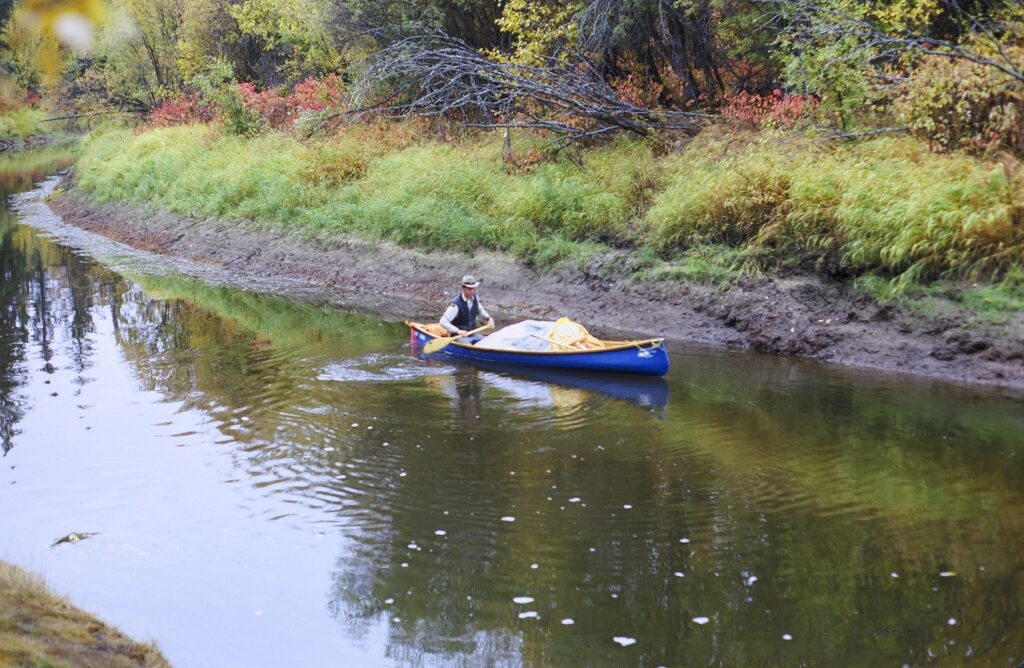
Jim Purdy on Boundary Patrol on the Little Buffalo River, WBNP. 1974
4737: Wood Buffalo had two logging operations at that time. One at Embress Portage on the Athabasca River that was monitored out of Fort Chip and the other one was at Garden River on the Peace River which the Fort Smith people looked after. We used to go out there 2-3 times a year and do a cutting inspection and check the mill. The people at the mill were extremely good to us; they fed us in the dining hall and let us sleep in the bunkhouse. My first trip was with Ray Frey just after I’d arrived in December and we travelled in an old bombardier. We drove to Peace Point the first day and took the bombardier and drove to Garden River the day following. It seemed to me it went on forever. We arrived in time for supper in the dining hall and then went to the bunkhouse. The bunkhouse was about the size of two old farm granaries, end to end with a big stove in the middle and wet clothes strung out to dry. I doubt there was any insulation and it smelled pretty high. We did our inspection and went back home the following day. Sometime later the Park erected our own Patrol Cabin at the air strip and we would either fly in or skidoo. We still ate in the dining hall but we didn’t have to go back in the bunkhouse.
MH: Do you have any photos of yourself as a warden that you would like to donate? Artifacts? 5003:
JP: I do have quite a few and could go through them and send them to you electronically.
MH: What year did you retire? 5040:
JP: I left the Warden Service at the end of June in 1977 and I went ranching in Manitoba. We were there for 9 years when I began having problems with my hip. My doctor said if I didn’t have a change in lifestyle, I would likely be in a wheelchair in 10 years so I decided to return to university and finish my teacher training. We moved back to Alberta and I went to University of Alberta. While I was at University my wife, a teacher as well, got a job at Frog Lake and I joined her on staff. I taught for a number of years and then became a principal and was an elementary school principal when I retired.
MH: What do you enjoy doing in retirement? 5250:
JP: My wife and I travel quite a bit and I have a woodshop in the garage and fiddle around there, especially in the winter. I am also a birder and I spend a lot of time watching birds, both around home and when we travel. The last two summers we have spent a great deal of time at rodeos as our grandson is competing in the wild pony races.
MH: Anyone else to interview? 5425:
JP: Jim Davies would be the only one off the top of my head but I think he’s been covered. Maybe track down Traf Taylor – He joined the two-man trail crew in Yoho about 1976 and then became a seasonal warden in Lake Louise. He was a very competent skier and took to climbing quickly. The last I heard he went to Pacific Rim as a permanent Warden. Years later we were out there on a whale watching trip and I was talking with our guide about Traf and he told me got his marine papers and became a master for big ships. He would have a very interesting story. I’m sure he’s still out on the coast somewhere but I don’t know where you’d track him down. Perry Jacobson may know.
Another prospect is Dr. Rex Coupland. He worked for Parks Canada and Environment Canada and was stationed at Fort Smith, NWT for a number of years. He worked extensively with the Bison. He currently resides in the Beaverlodge area.
MH: Any final comments? 5658:
JP: I can’t think of much more. I was tickled when you called up and wanted me to join the oral histories. When are they going to put this out in printed form? Occasionally they have one on the website but not all of them. (I explained they go to the archives of the Whyte Museum and maybe one day they will all be on the website. And maybe eventually it’ll be compiled into a book).
Jim was very appreciative of being interviewed.
This interview was conducted by Monique Hunkeler
Monique Hunkeler first started working with Parks Canada in 1989 as Secretary to Banff National Park Finance Manager. She moved into a position as Dispatcher for the Banff Park Warden Service and later worked within Banff National Park and Town of Banff’s IT departments. She is experienced with the interviewing, transcription and archiving process the Park Warden Service Alumni Society.
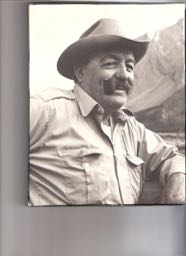

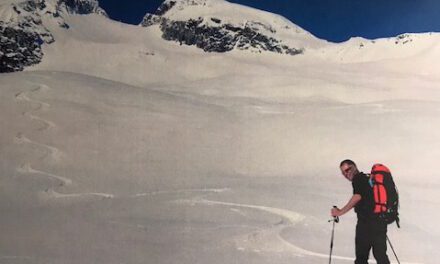
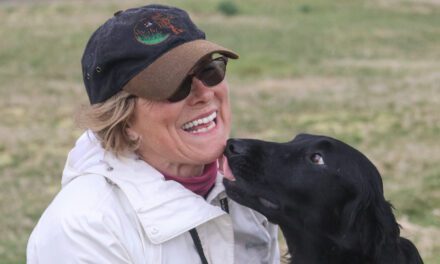
I can relate to the Wood Buffalo stories. I replaced Sandy McLean in !978.